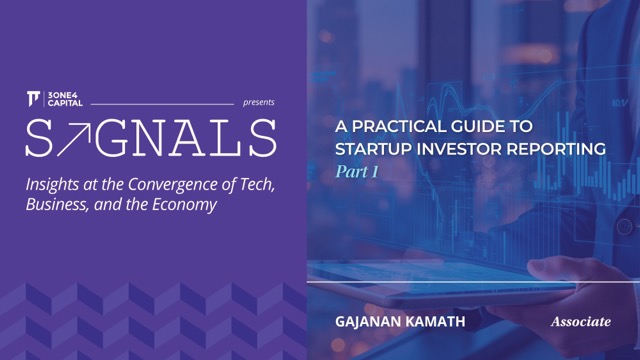
A Practical Guide to Startup Investor Reporting - Part I
Today’s challenging funding environment has resulted in a significant focus on transparency from an investor financial reporting perspective. Startups and founders today, are often faced with a conundrum on building a framework/template that is adequate, comprehensive, reliant to maintain investor trust and confidence. As VC funding becomes more selective and competitive, transparent, accurate, and timely financial reporting has become a critical tool for building investor confidence as well as enabling timely internal analysis to ensure sustainable growth.
With increased focus on corporate governance and accountability, having a well-structured monthly investor reporting format is not just a good practice—it’s a necessity for maintaining investor trust, securing future funding rounds, and positioning the company for long-term success. At the core, financial reporting processes serve as the primary communication channel between a company and its investors and also serve as the the primary input for enabling comprehensive internal analysis at the enterprise. When a company doesn’t establish a clear and consistent reporting format, it leaves room for confusion. This lack of clarity can undermine investor confidence, wherein key financial metrics (such as revenue growth, margin analysis, cash burn, etc.) key operating metrics (such as ARR and user retention for a SaaS company) are critical to assessing a company's trajectory.
This article is the first part of a Series wherein we will deep dive into the importance of building a good investor reporting framework for a startup and also cover the best sector wise practices that can be followed by startups while building their respective investor reporting templates. This series explores the key principles (from a financial reporting perspective) of creating an effective investor reporting format, ensuring transparency while safeguarding sensitive information.
As a first part of the series, this article will primarily focus on the importance of having a good investor reporting format in the current landscape and provide certain sector agnostic insights into building a good investor reporting format that can be leveraged by a first time founder or a new finance/investor relations professional to understand the reporting lens from an investor perspective.
Structuring Your MIS (Management Information System) Report
In financial reporting, more is never too much, transparency today builds trust for tomorrow, laying a stronger foundation for growth. Similar to the SMART acronym in goal setting exercises, it is critical for a new company to follow the same principles right from incorporation in order to build a reliance financial reporting framework:
Simple: Investor reporting frameworks should be specific and simple in order to capture all the key financial (such as ARR, Gross Margin, Contribution Margins, Cost classifications) and operating (LTV, NRR, NPS, CAC, Retention, LTV:CAC, CAC Payback, etc.) metrics to provide a complete picture yet not indulge in a data overload for the reader.
Meaningful: Make sure the data you provide is not only relevant but also impactful. Present metrics that tell a compelling yet transparent view about your company’s growth, profitability, and sustainability.
Accurate: While this goes without saying, it is critical to ensure accuracy of reported data to build reader’s confidence (For example: retrospective policy changes resulting in change of prior period data can significantly hamper investor confidence on the reporting efficiency).
Robust: An investor reporting template should be comprehensive and well-rounded, covering all the essential aspects of your business performance (Example: Several MIS formats today do not contain key parameters such as the balance sheet of the Company, founder estimated projected runway, deviations from budgets, etc. which ideally are key parameters from an investor’s perspective).
Timely: Timely reporting builds investor confidence, provides a clear view of your company’s current position, and facilitates quick decision-making for future planning - The timelines for an MIS submission are generally agreed upon in the transaction documents and adhering to these timelines is an excellent method of building trust in the capability of the financial reporting teams.
While the above fundamentals sound simple and easy to follow, investor reporting formats of several companies today often miss the above basics thus resulting in multiple iterations with the investors thereby reducing investor confidence on the quality of reporting. A couple of examples include:
- Non-alignment of MIS with the books of accounts thereby resulting in significant differences between the MIS and the audited financial statements;
- Non-correlation or mismatch between the operating and financial metrics (eg: Significant differences between Monthly Recurring Revenue reported in the operating metrics and the monthly subscription revenue credited to the income statement);
- Including irrelevant data or unstructured reporting in the MIS resulting in data overload for the investors (such as including raw CRM data for a SaaS startup instead of providing a summary on the retention metrics might result in a significantly bulky investor reporting template that may not be relevant for the investor);
- Non-inclusion of key data points such as movement in cash balances, historical and projected runway and key operating metrics such as return rates for D2C companies and retention rates for a SaaS company;
- Amending prior period metrics while during investor reporting of the subsequent months to rectify prior period errors or omissions;
- Delayed investor reporting despite of repeated follow-ups from investors, etc.
In today's competitive funding environment wherein investors have become increasingly selective, the above examples can result in crucial roadblocks in the fundraising process. Investors rely on MIS reports to evaluate the financial health, operational efficiency, and growth potential of a company and then validate these metrics through a comprehensive due diligence.
If the MIS is not aligned with the books of accounts, contains unexplained deviations, or lacks transparency, it raises red flags about the company's internal controls and governance which can lead to extended due diligence timelines, increased scrutiny, and, in many cases, lost funding opportunities. In a market where capital is scarce and competition for investor dollars is fierce, a poorly structured MIS can undermine investor confidence, resulting in lower valuations, reluctance to invest, or even outright rejection from potential backers.
Building a Comprehensive MIS Format
An ideal MIS format should always strive to cover datapoints that allow a reader to assess the profitability, liquidity, solvency, and overall financial health of the Company. To achieve this, it is important to structure the report in a logical and easy-to-navigate format that balances depth with clarity. A well-structured MIS typically consists of the following sections:
Executive Summary/Commentary on the performance for the reporting period covering the following:Sharing a commentary generally along with the MIS or before a board meeting gives the investors a company perspective to the performance of the Company and significantly reduces back and forth that eventually increases investor confidence.
- Performance highlights of the period covering commentary on key trends on revenue, margins, cash position, budget adherence and key operating metrics;
- Outlook for the next reporting period over the same metrics and the reasons for projecting the outlook;
- Summary over key strategic updates such as key employee updates, fundraise planning, regulatory changes, etc.
Financial Performance Overview:A company’s financial performance is the cornerstone of investor decision-making, making this section one of the most critical components of an MIS. Investors assess financial reports to gauge revenue trends, profitability, cash flow sustainability, and overall fiscal health. A well-structured financial overview not only ensures transparency but also allows investors to track progress against business objectives, assess financial discipline, and identify potential red flags. A robust MIS should provide an in-depth breakdown of financial performance, including:
- Statement of Profit/Loss or Income Statement covering a detailed view of the revenue, margins and profit or loss earned by the Company. The structure of the Income statement should be designed based on the business model of the Company in a way that all relevant income/expense streams are disclosed separately to give a comprehensive view to the reader.
- Balance Sheet as at the month end: Sharing the balance sheet with the investors is a good to have practice that allows the reader to evaluate the asset/liability position of the Company by factoring key metrics such as the working capital flows, debt position, etc.
- Cash Flow Statement reflecting the cash flow position across Operating, Investing, and Financing activities undertaken during the reporting period.
- Budget adherence via a Budget vs. Actuals compliance highlighting the differences with the budgets and a detailed reasoning for the same that allows the reader to gauge the operational efficiency of the Company;
- Cash and Debt dashboard reflecting the cash position of the Company (including the deployment of such cash in treasury and the corresponding yield earned) and the debt status (covering key metrics such as details of the lender, outstanding amount, effective interest rate, etc.)
Operational Metrics Overview:
- Including operating metrics in investor reporting MIS is crucial as they provide deeper insights into a company's performance beyond financial statements and can be key KPI’s based on which investor track the performance. These metrics help investors assess growth drivers, efficiency, and sustainability by tracking customer acquisition, retention, unit economics, and operational productivity. Clear and consistent reporting of these metrics enables investors to evaluate business scalability, identify potential risks, and make informed funding decisions.
- The decision on which operational metrics are required to be uploaded in the MIS should be made by factoring above fundamental ‘SMART’ acronym.
Conclusion:
A well-structured and transparent monthly investor reporting format is not just a tool for communication; it’s a cornerstone of good governance and a key factor in long-term success. Investor reporting is much more than just numbers—it’s about building trust, aligning stakeholders, and positioning the company for future growth. By focusing on the right financial and operating metrics, maintaining clarity and confidentiality, and preparing for future fundraising or public market opportunities, companies can leverage their monthly investor reports as a powerful tool to drive success.
In the next article under this series, we will cover specific financial and operating metrics that companies (per sector) should cover as part of their investor reporting formats and the sector wise good practices that should be followed to build a comprehensive investor reporting framework.

.png)












